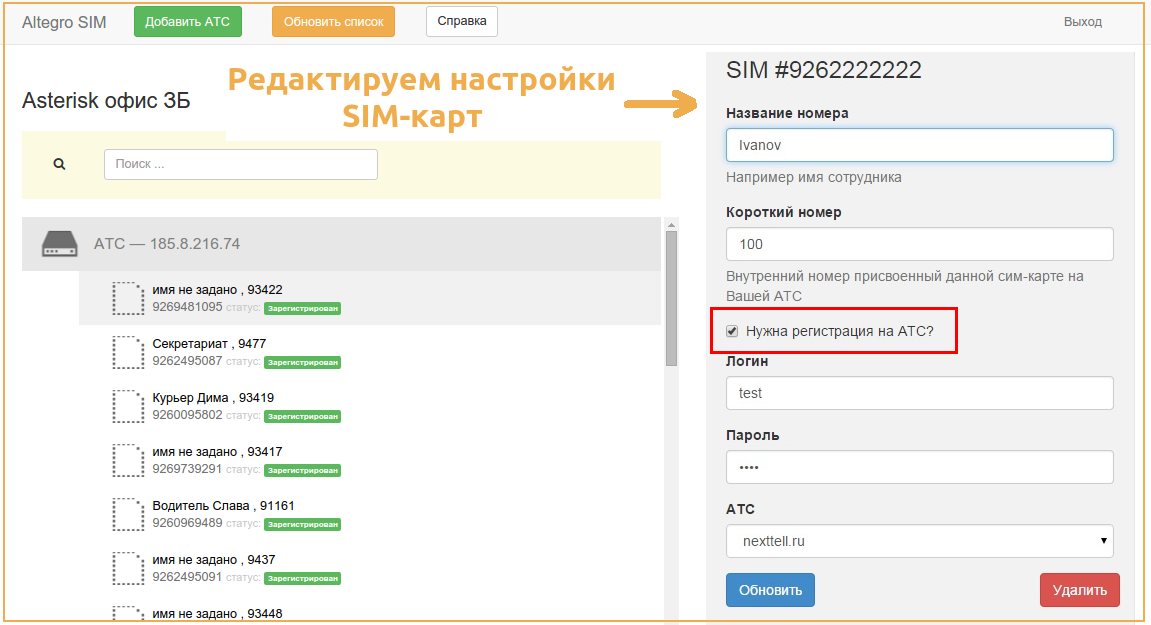We write our own interface management corporate FMC SIM-cards
What modern cloud service does without a personal account and API platform on which this service runs? Perhaps only the service running on mobile devices, and even then, not everyone. Our company had a short but stormy love affair with a simple proprietary softphone for Android, and even in such a seemingly simple project, we had a very long time behind the backend and admin web interface.
Since then, our developers have developed a certain approach: when productologists come up with another mega-product, assert it at the highest level and give it into development, the first thing that the Main Developer is interested in is “Will there be a personal account?”. “Yes,” answer product experts. “My account will be. Even two. ”For obvious reasons, a personal account was written for our project with special SIM cards AltegroSIM. Written so that customers can manage their SIM cards. We hope not to stop and “hang up” over time into a personal account and API, so that third-party services, those that may be interested in it, do the integration and their own personal computers.

About AltegroSIM, we have repeatedly written in our blog. These are FMC SIM cards issued within the framework of a joint project with the mobile operator Megafon and intended for corporate use. AltegroSIM connects directly to the virtual and IP PBX via SIP protocol and works like ordinary SIP devices, our switch acts as a gateway between GSM and SIP networks and, thanks to this, voice traffic from the SIM cards is routed first to our switch and then sent to the client's PBX. Partially SIM cards are controlled by us, which allows part of the management to be implemented on the side of our platform.
')
The scheme of the work of SIM cards is simple and complex at the same time, and it looks like it is shown in the diagram below.

The traffic from the GSM network, through the inter-operator interface, comes to our SIP switch, we see the ID of SIM cards, their status, a set of connected services and we can implement a SIM control interface that simulates an IP phone control interface: with logins, passwords, proxy, Stun on / off and almost all the rest of the VoIP-minced meat.
For the client, the service looks as if the SIM is a SIP device and is managed as a SIP device. The mobile phone turns into a “vulture with legs”


Employees from fixed phones call their colleagues' short numbers on the mobiles, employees on mobiles also dial accounting by a short number, all calls within the mobile and office network are approximately the same route, GSM is used only as the last mile.
The productologists decided that since the modified FMC SIM card had turned into an IP phone, it is quite logical and justifiable to write the management interface, which was done for the convenience of our clients and partners. Now there is no need to fill out accounting cards and order forms when connecting SIM cards, configure everything yourself through a personal account - assign short numbers, enter the login passwords of the internal extensions of the IP-PBX and immediately start working.
The client, after signing the contract, gets access to the management interface and sees a list of all SIM cards, the traffic from which is routed to his voice platform.

To configure SIM cards as subscriber devices for an arbitrary IP PBX, you need to add this PBX, specifying its IP and port.

Everything is quite simple. Now you can make changes to the company's mobile network, change short numbers, block SIM cards, disconnect or connect them to internal extensions or directly to trunks.
To add a new SIM to the company's mobile network, it is enough to indicate its identifier, which is issued upon connection.

An important and very pleasant moment, which will surely be of interest to our integrator partners and developers of their own services - the tick “Need registration on your PBX?”. If this check box is unchecked, then traffic from the selected SIM card will be marsursed directly to the specified IP address without any changes on the side of our switch.
This means that we simply perform the function of mobile voice traffic transit and if the integrator has an idea of his own product, he can easily implement it by replacing the A or B numbers, caller ID, making the necessary comparisons, i.e. can actually combine SIM cards into your own numbering plan.
The interface allows you to manage only the alarm and voice, the connection or disconnection of additional services is possible only in manual mode when you request to our support. But we are working to finally create a full-fledged API, with the help of which our clients or partners could independently connect and disconnect necessary services (for example, Internet or SMS packages), geodata and billing data,
We are not trying to repeat the MVNE scheme, which is popular in foreign networks, we are building an advanced client service that allows integrators or customers to add the necessary functionality to our product independently within the allowed options. We would be grateful for suggestions and feedback regarding the functionality of the AltegroSIM management interface . It is already obvious that a certain ecosystem is forming around our product and we want to promote its every development.
Since then, our developers have developed a certain approach: when productologists come up with another mega-product, assert it at the highest level and give it into development, the first thing that the Main Developer is interested in is “Will there be a personal account?”. “Yes,” answer product experts. “My account will be. Even two. ”For obvious reasons, a personal account was written for our project with special SIM cards AltegroSIM. Written so that customers can manage their SIM cards. We hope not to stop and “hang up” over time into a personal account and API, so that third-party services, those that may be interested in it, do the integration and their own personal computers.

About AltegroSIM, we have repeatedly written in our blog. These are FMC SIM cards issued within the framework of a joint project with the mobile operator Megafon and intended for corporate use. AltegroSIM connects directly to the virtual and IP PBX via SIP protocol and works like ordinary SIP devices, our switch acts as a gateway between GSM and SIP networks and, thanks to this, voice traffic from the SIM cards is routed first to our switch and then sent to the client's PBX. Partially SIM cards are controlled by us, which allows part of the management to be implemented on the side of our platform.
')
The scheme of the work of SIM cards is simple and complex at the same time, and it looks like it is shown in the diagram below.

The traffic from the GSM network, through the inter-operator interface, comes to our SIP switch, we see the ID of SIM cards, their status, a set of connected services and we can implement a SIM control interface that simulates an IP phone control interface: with logins, passwords, proxy, Stun on / off and almost all the rest of the VoIP-minced meat.
For the client, the service looks as if the SIM is a SIP device and is managed as a SIP device. The mobile phone turns into a “vulture with legs”


Employees from fixed phones call their colleagues' short numbers on the mobiles, employees on mobiles also dial accounting by a short number, all calls within the mobile and office network are approximately the same route, GSM is used only as the last mile.
The productologists decided that since the modified FMC SIM card had turned into an IP phone, it is quite logical and justifiable to write the management interface, which was done for the convenience of our clients and partners. Now there is no need to fill out accounting cards and order forms when connecting SIM cards, configure everything yourself through a personal account - assign short numbers, enter the login passwords of the internal extensions of the IP-PBX and immediately start working.
The client, after signing the contract, gets access to the management interface and sees a list of all SIM cards, the traffic from which is routed to his voice platform.

To configure SIM cards as subscriber devices for an arbitrary IP PBX, you need to add this PBX, specifying its IP and port.

Everything is quite simple. Now you can make changes to the company's mobile network, change short numbers, block SIM cards, disconnect or connect them to internal extensions or directly to trunks.
To add a new SIM to the company's mobile network, it is enough to indicate its identifier, which is issued upon connection.

An important and very pleasant moment, which will surely be of interest to our integrator partners and developers of their own services - the tick “Need registration on your PBX?”. If this check box is unchecked, then traffic from the selected SIM card will be marsursed directly to the specified IP address without any changes on the side of our switch.
This means that we simply perform the function of mobile voice traffic transit and if the integrator has an idea of his own product, he can easily implement it by replacing the A or B numbers, caller ID, making the necessary comparisons, i.e. can actually combine SIM cards into your own numbering plan.
The interface allows you to manage only the alarm and voice, the connection or disconnection of additional services is possible only in manual mode when you request to our support. But we are working to finally create a full-fledged API, with the help of which our clients or partners could independently connect and disconnect necessary services (for example, Internet or SMS packages), geodata and billing data,
We are not trying to repeat the MVNE scheme, which is popular in foreign networks, we are building an advanced client service that allows integrators or customers to add the necessary functionality to our product independently within the allowed options. We would be grateful for suggestions and feedback regarding the functionality of the AltegroSIM management interface . It is already obvious that a certain ecosystem is forming around our product and we want to promote its every development.
Source: https://habr.com/ru/post/271015/
All Articles